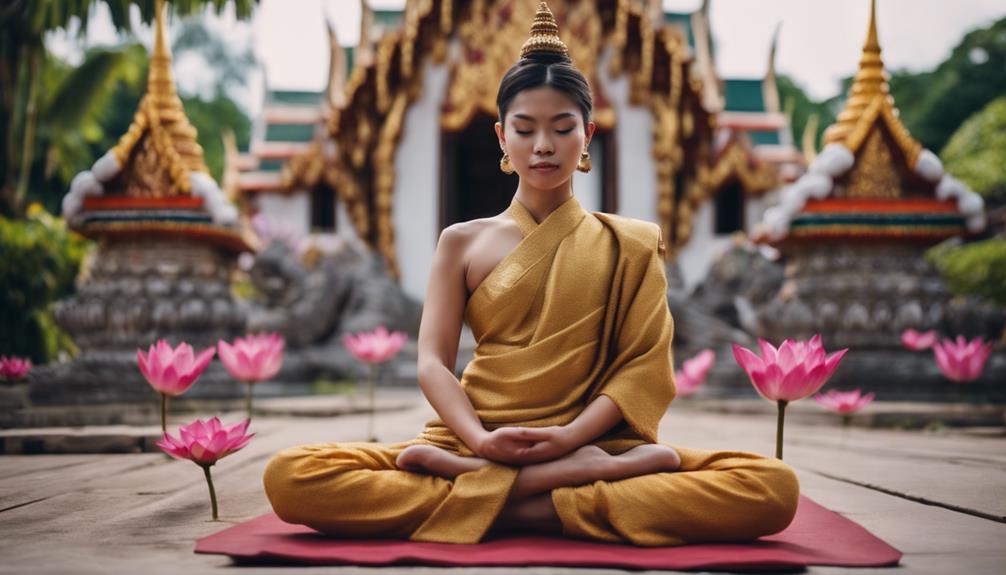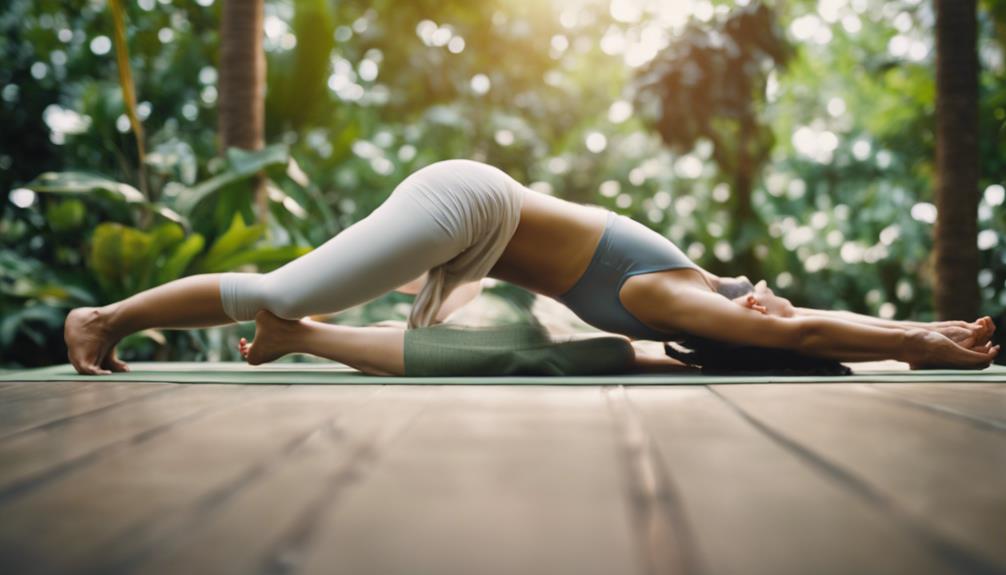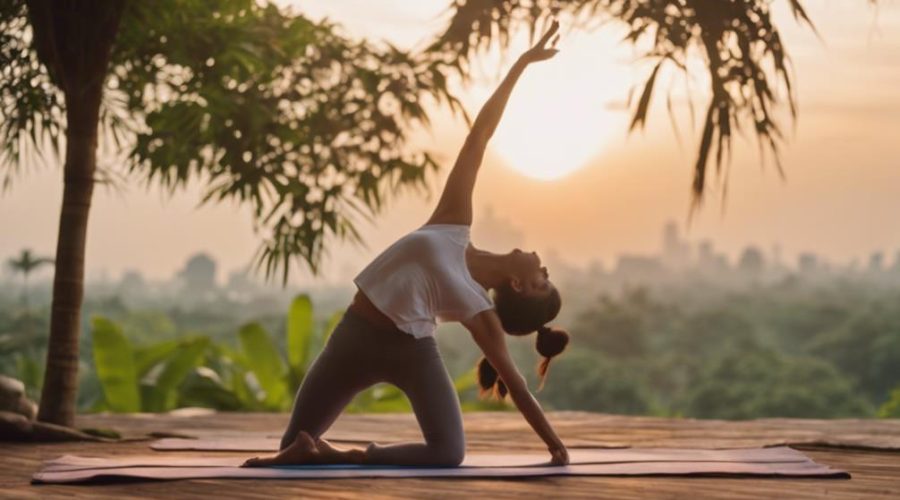What Is Traditional Thai Yoga?
Traditional Thai Yoga, or 'Ruesri Dat Ton', is an ancient mindfulness and self-healing practice deeply embedded in Thai wellness culture. This holistic approach promotes physical wellbeing and spiritual growth, interlacing movement, breath and meditation. With roots tracing back to Indian yogic scriptures and Buddhism, it integrates unique postures, deep stretches and breath work aiming for energy balance. It can furnish you with benefits including boosted flexibility, stress reduction, and heightened spiritual awareness. Mastering its unique discipline promises a transformative journey into wellness—a tantalizing prospect to explore further, isn't it?
Key Takeaways
- Traditional Thai Yoga is an ancient self-healing practice rooted in mindfulness and physical wellness.
- It is a unique discipline intertwining Buddhism, interconnectedness belief, movement, and breath.
- The practice involves meditation, breathwork, and postures, fostering inner peace and spiritual growth.
- Thai Yoga enhances flexibility, muscle strength, and promotes mental health, reducing stress and anxiety.
- Incorporating Thai Yoga into daily routine involves a yoga mat, comfortable clothing, patience, and personal adaptation of poses.
Understanding Traditional Thai Yoga

Diving into the world of Traditional Thai Yoga, you'll discover an ancient practice rooted deeply in the philosophy of self-healing and mindfulness, offering a holistic approach to physical wellness and spiritual growth. This practice is more than just a series of poses and stretches; it's a lifestyle that encompasses spiritual, mental, and physical aspects, enriching your life in a multitude of ways.
The cultural significance of Thai Yoga is immense, acting as a cornerstone of Thai wellness culture for centuries. It's not just about bending or twisting your body; it's about fostering a deep connection with your inner self and understanding the flow of energy within your body. This energy, or prana, is the life force that Thai Yoga aims to balance, leading to a healthier, more balanced you.
You'll also notice the unique Thai Yoga attire, an essential part of the practice. These loose, comfortable garments allow unrestricted movement and facilitate the flow of energy. They're typically made from natural, breathable materials, enhancing your comfort during practice. This attire, like the practice itself, symbolizes a return to nature and simplicity, reinforcing the core principles of Thai Yoga.
The Historical Roots of Thai Yoga
You'll find the roots of Thai Yoga in its ancient origins, deeply intertwined with spiritual practices of the past.
Buddhism's influence on this unique form of yoga is significant, shaping its philosophy and techniques.
Over time, Thai Yoga has evolved, integrating various elements to adapt to changing societal needs and cultural influences.
Thai Yoga's Ancient Origins
In order to truly grasp the essence of traditional Thai Yoga, it's crucial to delve into its ancient origins, tracing back to the spiritual practices of Indian monks over 2000 years ago. The roots of this practice are deeply intertwined with the yogic scriptures and the Ayurvedic influence.
These ancient texts provided a holistic approach to wellness, emphasizing the connection between mind, body, and spirit. They laid the foundation for Thai yoga's unique blend of meditation, breathwork, and postures. These disciplines were initially developed to assist monks in achieving a higher state of consciousness. It wasn't just a physical exercise but a spiritual journey.
Harnessing the wisdom of the past, Thai yoga continues to evolve, presenting a dynamic fusion of ancient practices and modern innovation.
Buddhism Influence on Practice
Rooted in the teachings of Buddhism, Thai Yoga reflects the religion's profound influence, integrating its principles of mindfulness, compassion, and the path to enlightenment into the practice. It's not just a physical discipline; it's a holistic approach that encompasses Buddhist meditation techniques and mindfulness in practice.
As you learn Thai Yoga, you're not just moving your body; you're also training your mind. You learn to maintain a state of mindfulness, focusing on the present moment without judgement. This mirrors the Buddhist practice of meditation, promoting mental clarity and tranquility. You'll also encounter the Buddhist principle of compassion, both for yourself and others, as you engage in this practice.
It's this fusion of mindfulness, compassion, and movement that makes Thai Yoga a unique and transformative experience.
Evolution of Thai Yoga
While exploring the practice of Thai Yoga, it's important to understand its rich historical roots that trace back to the early teachings of Buddhism in Thailand. Over time, this practice has evolved, embracing modern adaptations while maintaining its traditional essence.
It's remarkable to witness how Thai Yoga has developed from its humble beginnings in ancient temples to a globally recognized discipline. The global spread of Thai Yoga has been largely facilitated by its adaptability and relevance to modern lifestyles.
Today, you'll find Thai Yoga practitioners across the world, each bringing their unique interpretations and innovations to this ancient art. This evolution signifies the dynamic nature of Thai Yoga, constantly evolving yet always grounded in its deep historical roots.
Core Principles of Thai Yoga
Now, let's turn our attention to the core principles of Thai Yoga.
You'll discover the basic understanding of this practice, explore the myriad benefits it offers, and learn how to master the techniques.
This knowledge will be the foundation of your Thai Yoga journey, enhancing your physical well-being and spiritual growth.
Understanding Thai Yoga Basics
Diving into the core principles of Thai Yoga, you'll find that it's a unique discipline, intertwining mindfulness, movement, and the breath to promote physical strength, flexibility, and mental clarity.
At its heart, Thai Yoga's spirituality is rooted in Buddhism and the belief of interconnectedness of all things. This underpins every pose, stretch, and breath, fostering a deep sense of unity and harmony.
Thai Yoga also holds immense cultural significance, being an integral part of Thailand's wellness tradition for centuries. Its ceremonies, teachings, and practices are steeped in rich history and symbolism.
Understanding these basics, you can appreciate Thai Yoga not just as a physical activity, but as an empowering spiritual journey that fosters balance, wellness, and inner peace.
Benefits of Thai Yoga
Embracing the core principles of Thai Yoga can reveal a treasure trove of benefits for your physical health, mental clarity, and spiritual harmony. This ancient practice goes beyond the surface-level benefits of traditional yoga and takes you on a journey of self-discovery.
Here are some key benefits to take into account:
- Enhanced flexibility and muscle strength
- Improved circulation and detoxification
- Reduction of stress and anxiety
- Promotion of spiritual growth and self-discipline
- Accelerated healing and recovery
To fully reap these benefits, you need the right yoga attire. Recommendations include loose, comfortable clothing that allows for movement. Additionally, contemplate gaining Thai Yoga certifications. Not only can they deepen your practice, but they also offer an enriching pathway to personal growth and wellness. Thai Yoga is truly a path to holistic health.
Mastering Thai Yoga Techniques
After fully appreciating the myriad benefits of Thai Yoga, let's explore how you can master the techniques and core principles of this ancient practice.
Begin by ensuring you're wearing the right attire. Light, breathable clothing is recommended. Your outfit should allow for a full range of motion as Thai Yoga involves dynamic movements that stretch and strengthen the body. Essential equipment usage is minimal, but you'll benefit from a thick, comfortable mat for protection during postures and maneuvers.
As you immerse yourself further into the practice, you'll realize that Thai Yoga is more than just physical postures, it's also about energy flow and balance. Remember, consistency is key, and with time and dedication, you'll see progress and experience the transformative power of Thai Yoga.
Typical Thai Yoga Session Breakdown
Understanding a typical Thai Yoga session can greatly enhance your appreciation and practice of this ancient wellness tradition. It's an innovative, yet deeply rooted practice that starts with session preparation and emphasizes posture alignment.
The session typically unfolds in five stages:
- Preparation: You'll begin by focusing on breathing exercises to help calm the mind and prepare the body. You might also cleanse your space with incense or clear intentions.
- Warm-up: Gentle stretches are performed to prepare your muscles for the deeper work to come.
- Posture Alignment: This is the heart of the session. You'll learn and practice various poses, focusing on aligning your body in a manner that promotes ideal energy flow.
- Mindful Movements: These movements are designed to deepen the stretches, further enhancing flexibility and strength.
- Cool-down: You'll end the session by allowing the body time to absorb the benefits of the practice. This might include a meditative period or a relaxation pose.
As you progress, you'll find that each session becomes a unique blend of mindfulness, flexibility, and strength training. Embrace this traditional practice and discover a fresh way to enhance your holistic wellness journey.
Health Benefits of Thai Yoga

You'll be amazed at the myriad health benefits that Thai Yoga can offer you, from improving flexibility and strength to enhancing mental well-being. A consistent Thai Yoga practice can result in a lean, strong, and flexible body. Its dynamic movements help you burn calories, making it an ideal part of your Yoga Diet.
Thai Yoga is not just about physicality. It is a holistic practice that promotes mental wellness, too. It aids in reducing stress, anxiety, and depression by encouraging relaxation and improving your mood.
Let's explore more perks of Thai Yoga in this table:
| Benefit | Description |
|---|---|
| Flexibility & Strength | Thai Yoga helps improve your body's flexibility and strength, leading to better posture and balance. |
| Mental Wellness | It promotes mental health by reducing stress and anxiety levels, contributing to better sleep and mood. |
| Weight Management | With its calorie-burning movements, Thai Yoga can be a great addition to your Yoga Diet for weight management. |
| Improved Circulation | It boosts blood circulation, which can help detoxify the body and improve skin health. |
Opting for Thai Yoga means investing in a holistic wellness strategy that fosters physical strength, mental wellness, and overall health.
Incorporating Thai Yoga Into Your Routine
Ready to explore the world of Thai Yoga? Here's how you can effortlessly integrate this ancient practice into your daily routine for enhanced wellness. Thai Yoga is adaptable and can be customized to suit your lifestyle.
To get started, you'll need some basic Thai Yoga equipment. Don't worry, it's not as crucial as it sounds. Here's what you require:
- A Yoga mat: This is essential for your comfort and safety during the practice.
- Comfortable clothing: Choose loose-fitting clothes to facilitate easy movement.
- A small pillow: It can provide additional support and comfort.
- A quiet space: Create an environment where you can focus on your practice.
- Patience: Learning Thai Yoga takes time and practice.
Remember, Thai Yoga is about personal adaptation, so don't feel pressured to perfectly mimic every pose. Listen to your body's needs and adapt the poses accordingly. You might find some poses challenging initially, but with time, they'll become easier.
Incorporating Thai Yoga into your routine can revolutionize your physical and mental health. It's a journey of self-discovery and personal growth. So, why wait? Start your Thai Yoga journey today!



